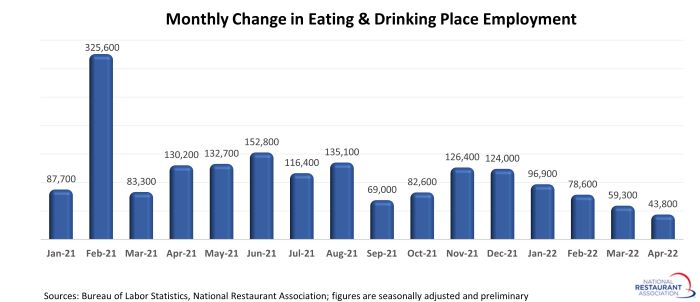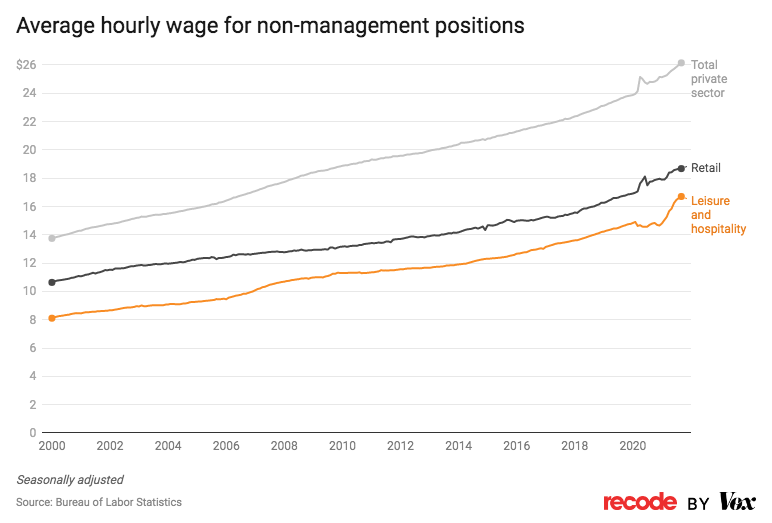In the spring of 2020, over 20 million Americans lost jobs due to the pandemic. Since then, the recovery has been slow, and the national labor shortage keeps making the headlines. Has the labor shortage impacted your pizzeria or quick-service restaurant? If so, you might be wondering:
- Is there an end in sight to the food service labor shortage?
- What are restaurants doing to combat the effects of the labor shortage?
- How can I attract and hire more workers at my restaurant?
- How can I protect my business from the labor shortage by retaining my best workers?
This article, Fighting Back Against the Food Service Labor Shortage, is the first in a series that will answer these important questions and more. Today we dive into the numbers to explore the scope of the food service labor shortage, its challenges, and future predictions.
The Scope of the Food Service Labor Shortage
The National Restaurant Association headline says it clearly: Restaurants continue to struggle to fill job openings. Statistics from April 2022 show that the restaurant and food service industry gained 43,800 jobs. The conclusion? “While gradual process is being made toward rebuilding the restaurant and food service workforce, much work has yet to be done.”

The problem is that the number of hires is just a fraction of the demand for workers, as indicated by job openings. From October 2021 through March 2022, the number of unfulfilled job openings in the hospitality sector has exceeded the number of hires by an average of 500,000 each month.
The graph below shows the total monthly hires versus end-of-month job openings since 2001. It demonstrates that we are in an atypical period and, “Until these two indicators converge to become more in line with historical trends, the warning lights of a labor crisis will continue to blink red.”

Research from surveys of restaurant operators echoes the points made above. In a survey of 3,000 restaurant operators and 1,000 adult customers, the National Restaurant Association found that seven out of ten operators do not have enough employees to support demand at their restaurants.
Moreover, most respondents said they don’t anticipate the labor situation to improve in 2022. Operators surveyed said they believe it will be at least a year before the challenges subside.
Consequences of the Food Service Labor Shortage
The effects of the labor shortage will differ depending on your restaurant type and the market you are in. However, here are some general ways the shortage may affect your operations.
Customer Experience Suffers
With fewer employees on hand to serve guests, the customer experience may suffer. Specifically, the wait times may be longer than usual, which may frustrate or anger your customers. This could mean an uptick in negative reviews or customers taking their business elsewhere.

Employee Burnout
Being short-staffed means that the employees who show up have a greater burden on their shoulders. They may have to work larger sections, handle more responsibilities, and the stress they feel on the job may increase.
Employee Turnover
As a result of burnout – or simply because there are so many attractive job opportunities available right now – you may face a higher employee turnover rate. Not only does this leave your restaurant short-staffed, but it can also be incredibly frustrating if you’ve taken the time to train employees who end up leaving.
Competition for Workers
The labor shortage impacts almost all industries, not just food services. With so many jobs available, potential employees can be more selective than normal. Since food service jobs are typically low pay (even though wages have been rising—see our Predictions section), it can be hard for restaurants to compete.
Shrinking Profit Margins
Having fewer staff members means you’ll likely see a decrease in the number of checks you can do in a night. Further, increased employee wages, overtime pay, and higher food prices can reduce your revenue and result in a smaller profit margin.
Predictions Based on the Food Service Labor Shortage
The numbers indicate that the food service labor shortage will continue in the months to come. And perhaps you are already feeling some of the consequences we discussed above. So, what does the future hold for the food service industry? Here are a few predictions about how the labor shortage could impact the industry in the long term.
1. It’s more than just salary.
Pay for non-managers in the leisure and hospitality sector has increased dramatically since the pandemic. But as the labor shortage indicates, higher pay is not enough to fill the job openings in the food service industry.

While a competitive wage will always be an important factor for job seekers, this indicates that there are other things restaurant operators must consider in finding and retaining quality workers. Stay tuned, as we will discuss specifics in a future article.
2. Reduce reliance on workers.
With fewer employees to do the work, restaurant operators must be creative about getting things done and continue to serve their customers. One way is to reduce the reliance on workers. This means we could see:
- Changes in purchasing that reduce employee time (for example, buying pre-cut vegetables that cost more but don’t require an employee to do the work)
- Exploring and investing in technology that will reduce manual labor (including pizza robots, which we discussed in this article).
- Automating processes, such as expanding the way customers can order and enabling employees to take orders faster (for example, cloud phone systems that connect to your CRM and POS)
According to research from Square, 91 percent of restaurants plan to invest in automation technology, including ovens that accelerate the cooking process and tableside ordering and payment systems.
3. Building customer trust is essential.
For restaurants to survive (and thrive) amidst the food service labor shortage, they must find a competitive edge—which is customer trust. There are two important areas to consider.
- Product Trust: Ensuring that items are available on the menu, food is high quality and fresh, and food safety is a top priority.
- Service Trust: Training employees to deliver top-notch customer service and establishing standards, so customers get a consistent experience every visit.
Demand Requires Solutions
The food service labor shortage has impacted the industry for over two years, and the numbers indicate that it’s not going away anytime soon. Restaurant owners need to find a solution fast because research suggests that consumer spending at restaurants continues to rise.

The National Restaurant Association reports that April’s sales volume was up 0.7 percent to $84.4 billion in total eating and drinking place sales for the month. This is the fourth consecutive monthly increase in consumers’ total spending at restaurants and bars and an optimistic sign for the food service industry.
The challenge for restaurant owners today is navigating the food service labor shortage to find the workers they need and continue to serve their growing customer base. In the next article of this series, we’ll discuss options for doing just that.



